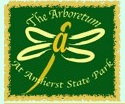Please use the navigation menu at bottom the Page
MenuGoHere
favicongohere


The Birds of Amherst State Park
The call came from Peter Yoerg. He was phoning to pass on a Buffalo Ornithological Society "hotline" bird. "There's a white-eyed vireo in the Glen," he said. "I found it near the south end of the picket fence."
And so another rare bird was recorded in the Williamsville Glen. Peter didn't have to say more about the location. Every serious local birder could find the spot he described without further directions. Peter's observation was added to the data I have accumulated about spring migrants in the Glen. As I entered it in my computer, I noted that one other white-eyed vireo, a southern species that occasionally overshoots its normal breeding grounds to appear here briefly, was seen there six years ago.
Since I couldn't get away to look for the bird, I forgot the call until I received an e-mail message from Dave Suggs. Dave told me that he had also found the vireo in the Glen but he added that he had read in this newspaper that the Sisters of St. Francis are planning to sell their Glen property. "Surely," he said, "we should be concerned about the possible loss of this wonderful natural area." That was the first I had heard of this. I had missed the "News" article and, when I read Dave's note, my heart sank.
Most people think of the Williamsville Glen as the park located on Glen Avenue that is administered cooperatively by the Village of Williamsville and the Town of Amherst. That park includes lovely trees, graceful walkways, broad open lawns and the Ellicott Creek falls where many wedding parties pose for pictures. But that park only extends about a hundred yards north of Glen Avenue and it does not include the wooded area at the Glen Avenue bridge. Those woods and all of the property along the creek past the Village Glen Tennis and Fitness Center on Mill Street and as far north as the Park Country Club fairways belongs to the Sisters of St. Francis. It is that area that birders refer to when they talk about "the Glen." And unfortunately it is that area that now may be lost to further Amherst development.
Here are some statistics that will mean little to those who seek to fill in every square foot of green space with office parks, condominiums or soccer fields. In eight years 138 bird species have been recorded there. On May 12, 1991, 73 species were observed in the Glen -- 22 of them warblers. A year earlier an even more remarkable 23 warbler species were found there in a single day and on some spring days 150 individual warblers may be seen. Over the years the species list has included olive-sided and yellow-bellied flycatchers; gray-cheeked thrush; Swainson's, worm-eating, Kentucky and Connecticut warblers; and the hybrid Brewster's warbler. Among nesting birds have been sharp-shinned and Cooper's hawks, screech and great horned owls.
Why this property is such a magnet for birds each spring is a mystery. My guess is that northward moving migrants swing east when they reach Lake Erie to avoid the overwater flight. When they get to the east end of the lake many turn to follow the Niagara River, but others swing off to the northeast and the Glen is one of the first woodlands where they can pause.
Unfortunately statistics like those I have cited have not deterred developers' bulldozers in the past. I hope that this natural area can be saved, but it would be a good idea to hurry there to see the end of this year's migration.
It might be our last chance -- Gerry Rising
Glen (Warblers vs. Bulldozers)
Buffalo News column was first published on May 20, 1997









